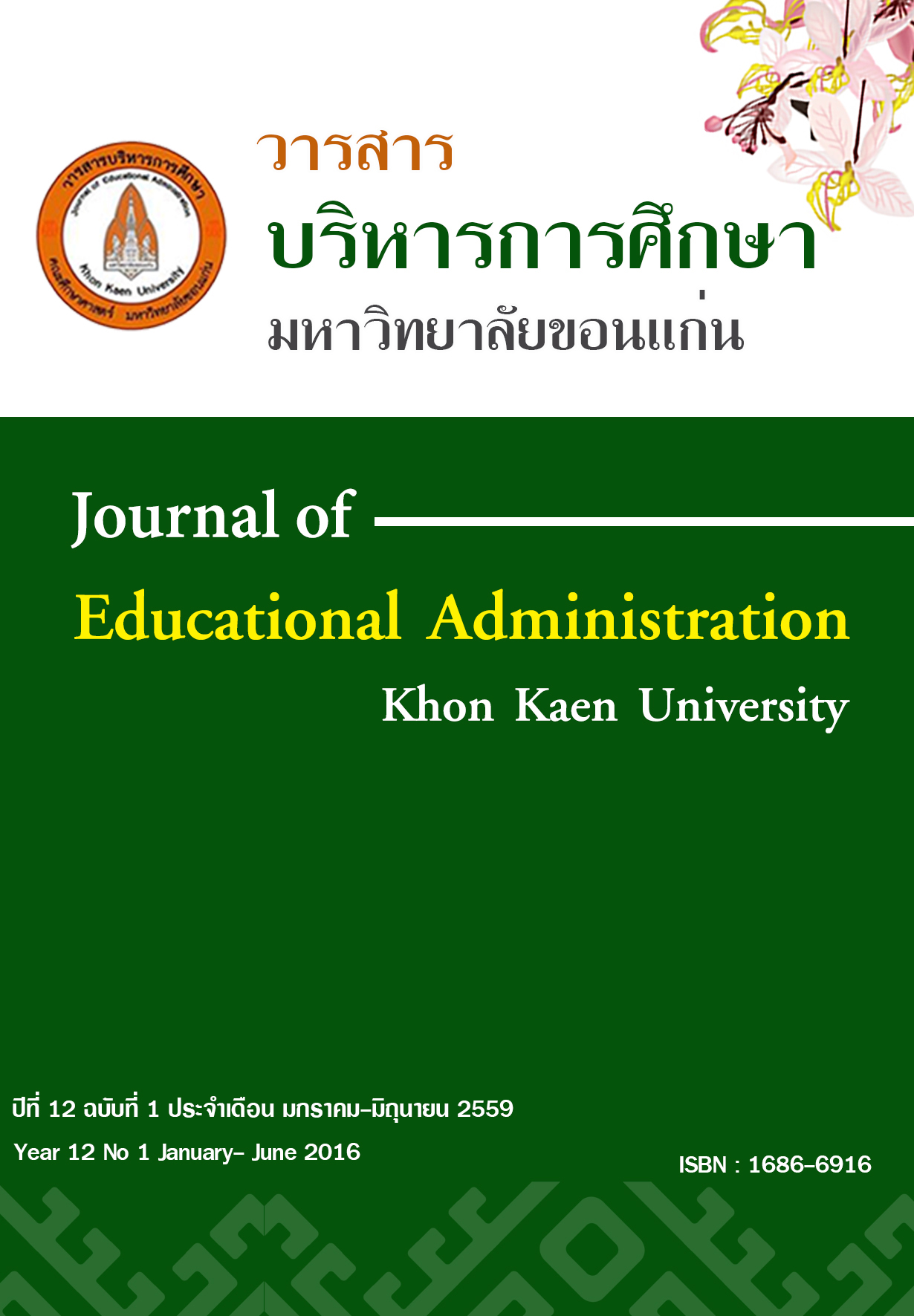การพัฒนาโมเดลเชิงสาเหตุการบริหารจัดการสู่ความสำเร็จ ของโรงเรียนมัธยมศึกษา สังกัดสำนักงานเขตพื้นที่การศึกษามัธยมศึกษา ภาคตะวันออกเฉียงเหนือ A Development of the Causal Model Toward Successful Management of Secondary Schools Under the Secondary Education
Main Article Content
Abstract
การวิจัยเรื่อง “การพัฒนาโมเดลเชิงสาเหตุการบริหารจัดการสู่ความสำเร็จของโรงเรียนมัธยมศึกษา สังกัดสำนักงานเขตพื้นที่การศึกษามัธยมศึกษา ภาคตะวันออกเฉียงเหนือ” มีวัตถุประสงค์ของการวิจัยดังนี้ 1) เพื่อพัฒนาและตรวจสอบความสอดคล้องของโมเดลเชิงสาเหตุการบริหารจัดการสู่ความสำเร็จ และ 2) เพื่อศึกษาอิทธิพลทางตรงและอิทธิพลทางอ้อมของโมเดลเชิงสาเหตุ กลุ่มตัวอย่างเป็นผู้บริหารสถานศึกษาโรงเรียนมัธยมศึกษา จำนวน 20 คน และครู จำนวน 480 คน รวมทั้งสิ้นจำนวน 500 คน โดยการสุ่มแบบหลายขั้นตอน ตัวแปรประกอบด้วย ตัวแปรแฝง 7 ตัว ได้แก่ การบริหารจัดการสู่ความสำเร็จ ภาวะผู้นำเชิงกลยุทธ์ การบริหารแบบมีส่วนร่วม ความเป็นมืออาชีพของบุคลากร การบริหารเชิงกลยุทธ์ วัฒนธรรมองค์การ และเครือข่ายร่วมพัฒนา ตัวแปรแฝงนี้วัดจากตัวแปรสังเกต 26 ตัว เครื่องมือที่ใช้ในการวิจัยเป็นแบบสัมภาษณ์เชิงลึก และแบบสอบถาม มีค่าความเชื่อมั่นอยู่ระหว่าง 0.60 -1.00 การวิเคราะห์ข้อมูลโดยการหาค่าเฉลี่ย ค่าส่วนเบี่ยงเบนมาตรฐาน ค่าสัมประสิทธิ์การแปรผัน ความเบ้ ความโด่ง ค่าสัมประสิทธิ์สหสัมพันธ์แบบเพียร์สัน การตรวจสอบความสอดคล้องของโมเดลเชิงสมมติฐานกับข้อมูล เชิงประจักษ์ และการวิเคราะห์อิทธิพลเชิงสาเหตุ
ผลการวิจัยสรุป ดังนี้
1. โมเดลเชิงสาเหตุการบริหารจัดการสู่ความสำเร็จของโรงเรียนมัธยมศึกษา มีความสอดคล้องกับข้อมูลเชิงประจักษ์ พิจารณาจากค่าสถิติที่ใช้ตรวจสอบความสอดคล้องระหว่างโมเดลกับข้อมูลเชิงประจักษ์ (c2 = 150.05, df = 166, p-Value = 0.80, GFI = 0.98, AGFI = 0.95, RMR = 0.00, RMSEA = 0.01, CN = 681.05) ตัวแปรในโมเดลสามารถอธิบายความแปรปรวนของการบริหารจัดการสู่ความสำเร็จ ของโรงเรียนมัธยมศึกษาได้ ร้อยละ 85
2. อิทธิพลทางตรง และอิทธิพลทางอ้อมของตัวแปรที่มีสัมประสิทธิ์อิทธิพลมาตรฐานตามลำดับดังนี้
2.1 ปัจจัยที่มีอิทธิพลทางตรงต่อการบริหารจัดการสู่ความสำเร็จของโรงเรียนมัธยมศึกษา มี 6 ตัว คือ ภาวะผู้นำเชิงกลยุทธ์ (KSL1) โดยมีค่าสัมประสิทธิ์อิทธิพล เท่ากับ 0.70 และความเป็นมืออาชีพของบุคลากร (E2PP) มีค่าสัมประสิทธิ์อิทธิพล เท่ากับ 0.18 อย่างมีนัยสำคัญทางสถิติที่ระดับ .01 และวัฒนธรรมองค์การ (E4PP) มีค่าสัมประสิทธิ์อิทธิพล เท่ากับ 0.15 การบริหารแบบมีส่วนร่วม (E1PM) มีค่าสัมประสิทธิ์อิทธิพล เท่ากับ 0.05 และการบริหารเชิงกลยุทธ์ (E3SM) มีค่าสัมประสิทธิ์อิทธิพล เท่ากับ 0.02 อย่างมีนัยสำคัญทางสถิติที่ระดับ .05 และได้รับอิทธิพลตรงในทิศทางลบ จากเครือข่ายร่วมพัฒนา (E5DN) โดยมีค่าสัมประสิทธิ์อิทธิพล เท่ากับ - 0.08 อย่างมีนัยสำคัญทางสถิติที่ระดับ .05
2.2 ปัจจัยที่มีอิทธิพลทางอ้อมต่อการบริหารจัดการสู่ความสำเร็จของโรงเรียนมัธยมศึกษา คือ การบริหารแบบมีส่วนร่วม (E1PM) โดยมีค่าสัมประสิทธิ์อิทธิพล เท่ากับ 0.12 อย่างมีนัยสำคัญทางสถิติที่ระดับ .05
This research entitled “A development of the causal model toward successful management of secondary schools under the Secondary Educational Service Areas in the Northeastern” was designed 1) to develop and test the goodness of fit the causal model towards the successful management, and 2) to determine the direct and indirect effects of the causal model. The multi-stage random sampling was applied for 500 samples consisted of 20 principals and 480 teachers of the secondary schools. The seven latent variables measured from 26 observed variables consisted of the successful management; strategic leadership; participative management; professional of personnel; strategic management; organizational culture and development network. The research instruments applied for data gathering were an in-depth interview form and a questionnaire which its reliability was 0.60-1.00. The earned data were analyzed by mean, standard deviation, coefficient of variation, skewness, kurtosis, and Pearson’s product moment correlation coefficient. Besides, the goodness of fit of the hypothesis was tested with the empirical data and the causal factor analysis.
The research findings were revealed as follows :
1. The causal model towards the successful management of the secondary schools was fit to the empirical data verified by the statistics used for the goodness of fit test between the model and the empirical data then showed c 2= 150.05, df = 166, p-Value = 0.80, GFI = 0.98, AGFI = 0.95, RMR = 0.00, RMSEA = 0.01, CN = 681.05. The variables in the model could explain the variances of the successful management as 85 percent.
2. The direct and indirect effects of the variables which the respective standard influence coefficient showed as follows.
2.1 There were 6 factors which directly influenced on the successful management : the strategic leadership (KSL1) and professional of personnel (E2PP) with the influence coefficients which were equal to 0.70 and 0.18 respectively with the statistical significance at .01 level. Additionally, the organizational culture (E4PP); participative management (E1PM) and the strategic management with the influence coefficients equaled 0.15, 0.05 and 0.02 respectively with the statistical significance at .05 level. Moreover, the factor which negatively influenced from the development network has the influence coefficient equaled -0.08 with the statistical significance at .05 level.
2.2 The factors which indirectly influenced on the successful management was the participative management (E1PM) with the influence coefficient equaled 0.12 with the statistical significance at .05 level.


